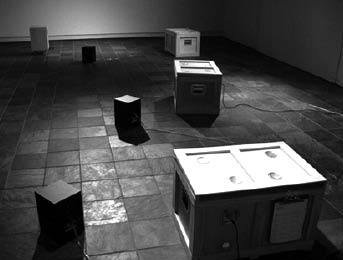Fluorescence and Decay
by Albert Chao

Hallwalls Contemporary Arts Center currently hosts two artists who explore two different senses: Paul Dickinson’s Music for Worms and Compost amplifies the sounds of worms, critters and decomposing compost, while Eric Brown captures light with fluorescent sculpture pieces.
Chicago artist Paul Dickinson’s Music for Worms and Compost is an audio and visual installation that emphasizes the small and the overlooked. Inside three wooden crates, hundreds of red worms and critters are decomposing various organic wastes, including bananas, red potatoes and eggshells. Microphones and infrared cameras relay the movements and sounds of the worms and critters to video screens and speakers. Sound is amplified, making their movements unavoidable for the audience.
The installation is pseudo-scientific. Dickinson terms some of his previous work as bioacoustic research, playing off similar studies in bird calling or differentiating sounds made by various species. In the past he has recorded the sounds of ants, sheep grazing and hermit crabs, as well as a colony of flesh-eating dermestid beetles cleaning the carcasses of a mouse and bird.
This installation is a continuation of his previous bioacoustic research. The decomposition process, however, ocurs at a remove; one only hears and sees through the use of video and sound equipment. In addition to the occasional ticks and cracks from the worms, the amplification of the sound generates a low resonance of electronic static and invokes a quiet uneasiness. The projected video screens are black and white and fuzzy infrared depictions. The physical isolation of the worms and critters yields an eerie, sterile experience. In this musical fugue, Dickinson is the conductor, the worms are the performers, and the viewers are the audience.
The wooden crates are designed for shipping and portability. The crates are shipped from one exhibition to another, as Dickinson jokes: “These worms have traveled.” Crates protect their contents, whether those contents are worms or artwork or both; the worms inside these portable crates are packaged goods as well as sculpture pieces. Interest in organic foods and the environment could create a thriving market for these portable wooden crates. Thus Dickinson maneuvers his worms from science laboratory to fine art to commodity, creating a cyclical aura: soon in every home, a ready-to-go compost box.
In the adjoining space of the exhibition, the moveable walls subtly divide one open space into three. New York-based artist Eric Brown sets four light sculpture pieces against the wood floor in his installation Terminals. Each sculpture piece is composed of stacked fluorescent glass that gives off an incandescent glow.

Brown uses light to open up space. Light, an intangible medium, is contained and suspended. It both extends out into the gallery space but also remains encapsulated within glass. It is free and trapped, open and closed.
Developed from architectural plans of airports, Terminals explore points of connection. Each point is both a beginning and an end. Airport terminals are spaces that are both departure and destination. Brown’s sculptures reflect the use of light in contemporary terminals, including New York City’s John F. Kennedy Airport and the Buffalo Niagara International Airport, where glass and steel structure and lighting open up space. The sculptures become architectural study models of light—an often overlooked detail that can have considerable effects—and space.
Temperature is also manipulated. Of the four pieces, Brown describes one as “cooler” than the rest. The “cooler” fluorescent lighting gives off a slight hint of blue, whereas the others have a rosier glow. The result is a small off-kilter effect that plays with various shades of light.
Brown’s earlier work involved casting in hydrocal, a white plaster material common in models for architectural practice. Brown’s artistic process in hydrocal mirrors his process in working with light. Using reusable molds, one element is casted repeatedly and then stacked, creating basic ideas of architecture including corners, walls and other notions of space.
Brown sees his use of fluorescent glass tubes as a logical step from his work in hydrocal. Hydrocal’s white color conveys a false sense of lightness, when in actuality it is a very heavy material. Fluorescent tubes both are and contain light. Brown is able to use the lightness of fluorescent tubes. In addition, the weightiness of hydrocal gives off a false impression of permanence and strength; the material is fragile and precarious. His new sculptures are of only light and glass. The pieces are weightless, yet still exert a strong influence over space.
Both exhibitions are at Hallwalls Contemporary Arts Center until February 17. For more information, please visit www.hallwalls.org.
Design Matters is presented in association with the UB School of Architecture and Planning and supported by a fellowship endowed by Polis Realty.
|
Issue Navigation> Issue Index > v6n7: It's Mardi Gras Time! (2/15/07) > Fluorescence and Decay This Week's Issue • Artvoice Daily • Artvoice TV • Events Calendar • Classifieds |









 Current Issue
Current Issue